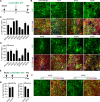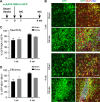This is a preprint.
Simple and Highly Specific Targeting of Resident Microglia with Adeno-Associated Virus
- PMID: 38168285
- PMCID: PMC10760038
- DOI: 10.1101/2023.12.12.571321
Simple and Highly Specific Targeting of Resident Microglia with Adeno-Associated Virus
Update in
-
Simple and highly specific targeting of resident microglia with adeno-associated virus.iScience. 2024 Aug 12;27(9):110706. doi: 10.1016/j.isci.2024.110706. eCollection 2024 Sep 20. iScience. 2024. PMID: 39297168 Free PMC article.
Abstract
Microglia, as the immune cells of the central nervous system (CNS), play dynamic roles in both health and diseased conditions. The ability to genetically target microglia using viruses is crucial for understanding their functions and advancing microglia-based treatments. We here show that resident microglia can be simply and specifically targeted using adeno-associated virus (AAV) vectors containing a 466-bp DNA fragment from the human IBA1 (hIBA1) promoter. This targeting approach is applicable to both resting and reactive microglia. When combining the short hIBA1 promoter with the target sequence of miR124, up to 95% of transduced cells are identified as microglia. Such a simple and highly specific microglia-targeting strategy may be further optimized for research and therapeutics.
Keywords: AAV; adeno-associated virus; human IBA1; lentivirus; microglia; virus transduction.
Conflict of interest statement
Conflict of interests A patent application was filed on using viruses to target microglia/macrophages.
Figures





References
-
- Leng F., Edison P., Neuroinflammation and microglial activation in Alzheimer disease: where do we go from here? Nat Rev Neurol 17, 157–172 (2021). - PubMed
Publication types
Grants and funding
LinkOut - more resources
Full Text Sources
Research Materials
